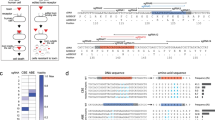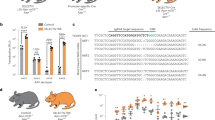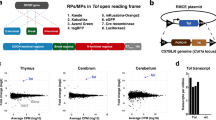Abstract
Specific cell ablation is a useful method for analyzing the in vivo function of cells. We have developed a simple and sensitive method for conditional cell ablation in transgenic mice, called “toxin receptor–mediated cell knockout.” We expressed the diphtheria toxin (DT) receptor in transgenic mice using a hepatocyte-specific promoter and found that injection of DT caused fulminant hepatitis. Three independently established transgenic lines demonstrated a good correlation between the sensitivity of hepatocytes to DT and the expression level of the DT receptors. Moreover, the degree of hepatocyte damage was easily controlled over a wide range of doses of injected DT without any obvious abnormalities in other cells or tissues. This system is useful for generating mouse models of disease and for studying the recovery or regeneration of tissues from cell damage or loss. As DT is a potent inhibitor of protein synthesis in both growing and non-growing cells, the method is applicable to a wide range of cells and tissues in mice or in other DT-insensitive animals.
This is a preview of subscription content, access via your institution
Access options
Subscribe to this journal
Receive 12 print issues and online access
$209.00 per year
only $17.42 per issue
Buy this article
- Purchase on Springer Link
- Instant access to full article PDF
Prices may be subject to local taxes which are calculated during checkout





Similar content being viewed by others
References
Palmiter, R.D. et al. Cell lineage ablation in transgenic mice by cell-specific expression of a toxin gene. Cell 50, 435–443 (1987).
Breitman, M.L. et al. Genetic ablation: targeted expression of a toxin gene causes microphthalmia in transgenic mice. Science 238, 1563–1565 (1987).
Behringer, R.R., Mathews, L.S., Palmiter, R.D. & Brinster, R.L. Dwarf mice produced by genetic ablation of growth hormone-expressing cells. Genes Dev. 2, 453–461 (1988).
Breitman, M.L., Rombola, H., Maxwell, I.H., Klintworth, G.K. & Bernstein, A. Genetic ablation in transgenic mice with an attenuated diphtheria toxin A gene. Mol. Cell. Biol. 10, 474–479 (1990).
Lem, J., Applebury, M.L., Falk, J.D., Flannery, J.G. & Simon, M.I. Tissue-specific and developmental regulation of rod opsin chimeric gene in trangenic mice. Neuron 6, 201–210 (1991).
Ross, S.R., Graves, R.A. & Spiegelman, B.M. Targeted expression of a toxin gene to adipose tissue: transgenic mice resistant to obesity. Genes Dev. 7, 1318–1324 (1993).
Lowell, B.B. et al. Development of obesity in transgenic mice after genetic ablation of brown adipose tissue. Nature 366, 740–743 (1993).
Yamaizumi, M., Mekada, E., Uchida, T. & Okada, Y. One molecule of diphtheria toxin fragment A introduced into a cell can kill the cell. Cell 15, 245–250 (1978).
Greenfield, L. et al. Nucleotide sequence of the structural gene for diphtheria toxin carried by corynebacteriophage beta. Proc. Natl. Acad. Sci. USA 80, 6853–6857 (1983).
Collier, R.J. Diphtheria toxin: structure and function of a cytocidal protein. In ADP-ribosylating toxins and G proteins (eds. J. Moss & M. Vaughan) 3–19 (American Society for Microbiology, Washington, D.C., 1990).
Tsuneoka, M. et al. Evidence for involvement of furin in cleavage and activation of diphtheria toxin. J. Biol. Chem. 268, 26461–26465 (1993).
Sandvig, K. & Olsnes, S. Diphtheria toxin entry into cells is facilitated by low pH. J. Cell Biol. 87, 828–832 (1980).
Draper, R.K. & Simon, M.I. The entry of diphtheria toxin into the mammalian cell cytoplasm: evidence for lysosomal involvement. J. Cell Biol. 87, 849–854 (1980).
Honjo, T., Nishizuka, Y., Hayaishi, O. & Kato, I. Diphtheria toxin-dependent adenosine diphosphate ribosylation of aminoacyl transferase II and inhibition of protein synthesis. J. Biol. Chem. 243, 3553–3555 (1968).
Robinson, E.A., Hendricson, O. & Maxwell, E.S. Elongation factor 2: amino acid sequence at the site of adenosine diphosphate ribosylation. J. Biol. Chem. 249, 5088–5093 (1974).
Van Ness, B.G., Howard, J.B. & Bodley, J.W. ADP-ribosylation of elongation factor 2 by diphtheria toxin: NMR spectra and proposed structures of ribosyl-diphthamide and its hydrolysis products. J. Biol. Chem. 255, 10717–10720 (1980).
Kohno, K. et al. Amino acid sequence of mammalian elongation factor 2 deduced from the cDNA sequence: homology with GTP-binding proteins. Proc. Natl. Acad. Sci. USA 83, 4978–4982 (1986).
Kohno, K. & Uchida, T. Highly frequent single amino acid substitution in mammalian elongation factor 2 (EF-2) results in expression of resistance to EF-2-ADP-ribosylating toxins. J. Biol. Chem. 262, 12298–12305 (1987).
Kimata, Y. & Kohno, K. Elongation factor 2 mutants deficient in diphthamide formation show temperature-sensitive cell growth. J. Biol. Chem. 269, 13497–13501 (1994).
Pappenheimer, A.M., Harper, A.A., Moynihan, M. & Brockes, J.P. Diphtheria toxin and related proteins: effect of route of injection on toxicity and the determination of cytotoxicity for various cultured cells. J. Inf. Dis. 145, 94–102 (1982).
Mekada, E., Kohno, K., Ishiura, M., Uchida, T. & Okada, Y. Methylamine facilitates demonstration of specific uptake of diphtheria toxin by CHO cell and toxin-resistant CHO cell mutants. Biochem. Biophys. Res. Commun. 109, 792–799 (1982).
Naglich, J.G., Metherall, J.E., Russell, D.M. & Eidels, L. Expression cloning of a diphtheria toxin receptor: identity with a heparin-binding EGF-like growth factor precursor. Cell 69, 1051–1061 (1992).
Mitamura, T., Higashiyama, S., Taniguchi, N., Klagsbrun, M. & Mekada, E. Diphtheria toxin binds to the EGF-like domain of human heparin-binding EGF-like growth factor/diphtheria toxin receptor and inhibits specifically its mitogenic activity. J. Biol. Chem. 270, 1015–1019 (1995).
Kiso, S. et al. Role of heparin-binding epidermal growth factor-like growth factor as a hepatotrophic factor in rat liver regeneration after partial hepatectomy. Hepatology 22, 1584–1590 (1995).
Borrelli, E., Heyman, T., His, M. & Evans, R.M. Targeting of an inducible toxic phenotype in animal cells. Proc. Natl. Acad. Sci. USA 85, 7572–7576 (1988).
Kobayashi, K. et al. Immunotoxin-mediated conditional disruption of specific neurons in transgenic mice. Proc. Natl. Acad. Sci. USA 92, 1132–1136 (1995).
Watanabe, D. et al. Ablation of cerebellar Golgi cells disrupts synaptic integration involving GABA inhibition and NMDA receptor activation in motor coordination. Cell 95, 17–27 (1998).
Kaneko, S. et al. Synaptic integration mediated by striatal cholinergic interneurons in basal ganglia function. Science 289, 633–637 (2000).
Lee, P. et al. Conditional lineage ablation to model human diseases. Proc. Natl. Acad. Sci. USA 95, 11371–11376 (1998).
Iwamoto, R. et al. Heparin-binding EGF-like growth factor, which acts as the diphtheria toxin receptor, forms a complex with membrane protein DRAP27/CD9, which up-regulates functional receptors and diphtheria toxin sensitivity. EMBO J. 13, 2322–2330 (1994).
Pinkert, C.A., Ornitz, D.M., Brinster, R.L. & Palmiter, R.D. An albumin enhancer located 10 kb upstream functions along with its promoter to direct efficient, liver-specific expression in transgenic mice. Genes Dev. 1, 268–276 (1987).
Kobayashi. K. et al. Genetic alteration of catecholamine specificity in transgenic mice. Proc. Natl. Acad. Sci. USA 89, 1631–1635 (1992).
Han, J.H., Stratowa, C. & Rutter, W.J. Isolation of full-length putative rat lysophospholipase cDNA using improved methods for mRNA isolation and cDNA cloning. Biochemistry 26, 1617–1625 (1987).
Uchida, T., Pappenheimer, A.M. & Greany, R.J. Diphtheria toxin and related proteins. I. Isolation and properties of mutant proteins serologically related to diphtheria toxin. J. Biol. Chem. 248, 3838–3844 (1973).
Chen, Z-L. et al. Expression and activity-dependent changes of a novel limbic-serine protease gene in the hippocampus. J. Neurosci. 15, 5088–5097 (1995).
Acknowledgements
We thank Y. Kaneda for plasmid p2335A-1, S. Shiosaka and S. Yoshida for in situ hybridization, Y. Tsunoda and Y. Kato for advice about transgenic techniques, S. Kawata and Y. Matsuzawa for histochemical analysis of transgenic mice and R. Ando for technical assistance. We also thank M. Lamphier and I. Farcasanu for critical reading of the manuscript.This work was supported by a Grant-in-Aid from the Ministry of Education, Science, Sports and Culture of Japan.
Author information
Authors and Affiliations
Additional information
The online version of the original article can be found at 10.1038/90770
Rights and permissions
About this article
Cite this article
Saito, M., Iwawaki, T., Taya, C. et al. Diphtheria toxin receptor–mediated conditional and targeted cell ablation in transgenic mice. Nat Biotechnol 19, 746–750 (2001). https://doi.org/10.1038/90795
Received:
Accepted:
Published:
Issue Date:
DOI: https://doi.org/10.1038/90795
This article is cited by
-
A dedicated hypothalamic oxytocin circuit controls aversive social learning
Nature (2024)
-
C. difficile intoxicates neurons and pericytes to drive neurogenic inflammation
Nature (2023)
-
Targeting Peripheral μ-opioid Receptors or μ-opioid Receptor-Expressing Neurons Does not Prevent Morphine-induced Mechanical Allodynia and Anti-allodynic Tolerance
Neuroscience Bulletin (2023)
-
New transgenic mouse models enabling pan-hematopoietic or selective hematopoietic stem cell depletion in vivo
Scientific Reports (2022)
-
Emerging strategies for the genetic dissection of gene functions, cell types, and neural circuits in the mammalian brain
Molecular Psychiatry (2022)



